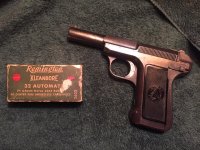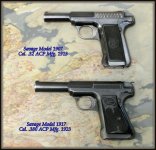DocB
Member
Walked into my LGS today as another guy was walking out. Saw this gun laying behind the counter and bought it for $140 plus tax. The man leaving the store had just sold it to them. Found some old Remington 32's from the 1970's in my ammo stash. Standing back about 20 feet, put a clip full into an area the size of my hand. . .always shoot them before you clean them up. I don't know much about these things since I mostly collect Smiths. It might be 85%. Hard to say. Sure does shoot good. It has the 1905 patent on the top of the receiver, but they say this type gun was more of a model of 1907. The SN is 2019XX. What do the experts say? Age? Value? Whatever? Any information is appreciated.





